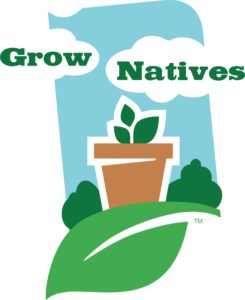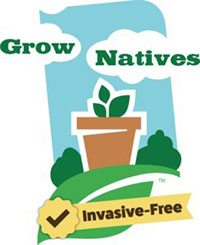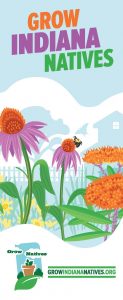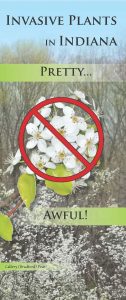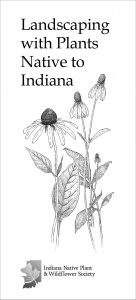Why is the Indiana Native Plant Society promoting the Grow Indiana Natives program? The majority of invasive plants were introduced through landscaping. For example, about 86% of invasive woody species, like Asian bush honeysuckle, Callery pear (aka Bradford pear), privet, and burning bush, originated with landscape plantings. An increasing number of gardeners and landscapers are becoming aware of this, and want to plant natives so they are not contributing to the problem. The intent of Grow Indiana Natives is to help these customers find a source for native plants and encourage plant sellers to sell more native plants and fewer invasive plants.
What is an invasive plant? An invasive plant is a non-native plant that infests natural areas and causes environmental or economic harm, or harm to human health. About one-third of the roughly 2,900 plant species growing outside of cultivation in Indiana are non-native, but only a small fraction of those non-native species are invasive. Invasive plants degrade and destroy thousands of acres of our natural plant communities in Indiana. Each year millions of dollars are spent to control them in Indiana alone.
Why should I care about invasives? (1) Invasive plants cost money. A 2012 survey of 120 agencies and landowners in Indiana found we spent $5.7 million to manage these species and protect our natural areas. Nationally, agricultural and control costs due to invasive plants are estimated at $15 billion per year. Each year the cost grows. (2) Invasive plants hurt wildlife by crowding out the plants our native animals need for food and cover. (3) Most invasive shrubs and trees are little used by native insects. This reduces habitat for beneficial pollinators and predatory insects, as well as reducing the amount of food available for birds to feed their nestlings. (4) Invasive plants destroy habitat for rare wildflowers and animals, threatening two-thirds of all endangered species. (5) Invasive plants can become weedy in a home garden, crowding out other landscaping. (6) Invasive plants can also decrease your ability to enjoy hunting, fishing, mushroom collecting, bird-watching, and many other recreational pursuits by crowding forest floors and choking waterways, making use of these areas difficult.
For more information on invasive plant impacts in Indiana and what you can do to help, visit the Invasive Plant Advisory Committee website.
Why should I join the Grow Indiana Natives program? With over $2.5 million dollars in sales per year, the Indiana horticulture industry has a big impact on the Hoosier economy, and accounts for nearly 32,000 jobs in the state. By stopping the spread of invasive plants, horticulture businesses can simultaneously serve their customers, protect the environment, and save Hoosiers millions of dollars. We can be proactive rather than wait for regulations. Grow Indiana Natives makes it easy to find out which plants are invasive and which plants are better choices to sell. An increasingly aware gardening public is looking for businesses that provide environmentally friendly plants. Join Grow Indiana Natives now to be part of this practical solution.
How do I know whether a plant is native, non-native, or invasive? Many resources can help you determine whether a species is native, non-native, or invasive. Common Natives in Horticulture is a list of many of the Indiana natives that are for sale at nurseries and retailers. The USDA PLANTS database is a useful resource to look up the native range of plant species. Finally, the list of invasive plants in Indiana is found here.
I sell native plants, but I also sell invasive plants. Can I be part of the Grow Indiana Natives program? Yes! You can be a Basic Grow Indiana Natives member even if you still sell invasive plants. This entitles you to a Basic Grow Indiana Natives certification and free native plant promotional materials, and to appear in a list of native plant sellers in Indiana. If you stop selling invasive plants, you will qualify for Invasive-Free Grow Indiana Natives status, which includes ad space in our Buy Natives Directory and a link to your website.
How does Grow Indiana Natives treat cultivars of invasive plants? Cultivars are a cultivated variety of the parent species. Grow Indiana Natives considers all cultivars to have the same level of invasiveness as the parent species unless testing has shown that they are not invasive. At this time, we do not know of any cultivars of invasive plant species that are not themselves invasive.
Are “nativars” considered native species? “Nativars” are cultivars of native species. Just as we consider cultivars of invasive species to have the same properties as the parent species, we consider nativars to be native as well. However, we note that some nativars have been shown not to provide the same level resources as the native plant (see this National Wildlife Federation article for discussion). We also note that when the planting goal is to restore a natural area, the use of local genotype materials is appropriate.
I sell native plants—how do I join Grow Indiana Natives? Enroll in Grow Indiana Natives by filling out this form. The Grow Indiana Natives committee will review your application to determine if you meet the criteria and then contact you. Once accepted into the program, you will be able to order brochures and promotional materials online.

